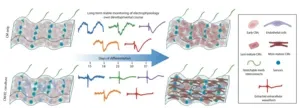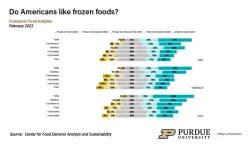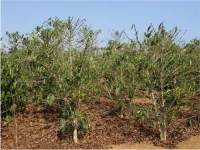(Press-News.org) While the crowds swarm around Old Faithful to wait for its next eruption, a little pool just north of Yellowstone National Park’s most famous geyser is quietly showing off its own unique activity, also at more-or-less regular showtimes. Instead of erupting in a towering geyser, though, Doublet Pool cranks up the bass every 20 to 30 minutes by thumping. The water vibrates and the ground shakes.
Doublet Pool’s regular thumping is more than just an interesting tourist attraction. A new study led by University of Utah researchers shows that the interval between episodes of thumping reflects the amount of energy heating the pool at the bottom, as well as in indication of how much heat is being lost through the surface. Doublet Pool, the authors found, is Yellowstone’s thumping thermometer.
“By studying Doublet Pool, we are hoping to gain knowledge on the dynamic hydrothermal processes that can potentially be applied to understand what controls geyser eruptions,” said Fan-Chi Lin, an associate professor in the department of geology and geophysics at the U and a study co-author, “and also less predictable and more hazardous hydrothermal explosions.”
The study is published in Geophysical Research Letters.
Not exactly like a geyser
Doublet Pool is, as the name implies, a pair of hydrothermal pools connected by a small neck. It would fit comfortably in one half of a tennis court. It’s situated on Geyser Hill in Yellowstone National Park, across the Firehole River from the hotels, visitor centers and parking lots that surround Old Faithful.
“We knew Doublet Pool thumps every 20-30 minutes,” Lin said, “but there was not much previous knowledge on what controls the variation. In fact, I don't think many people actually realize the thumping interval varies. People pay more attention to geysers.”
The thumping, Lin said, which lasts about 10 minutes, is caused by bubbles in the plumbing system that feeds water, heated by a magma system beneath Yellowstone, to Doublet Pool. When those bubbles of water vapor reach the cool upper reaches of the hydrothermal conduit, they collapse suddenly. Thump.
A similar process happens in geysers and excites “hydrothermal tremor,” Lin said, but occurs deeper in the hydrothermal system, at depths of about 30-60 ft and ends with the geyser releasing pressure through a narrow opening as an eruption. Doublet Pool does not have a plumbing structure that enables pressure accumulation and hence no eruption occurs. Also, scientific instruments placed in and around the pool aren’t at any risk for being regularly blown out.
So, to better understand how hydrothermal systems work, Lin and his colleagues, including Cheng-Nan Liu, Jamie Farrell and Sin-Mei Wu from the U and collaborators from the University of California, Berkeley and Yellowstone National Park, set up instruments called geophones around Doublet Pool in seven deployments between 2015 and 2021. In winter 2021 and spring 2022, with the permission of the National Park Service, they lowered temperature and water-level sensors into the pool itself. Then they watched, waited and listened.
Like blowing on a pot of pasta
The researchers focused on the silence interval, or the time between periods of thumping. They found that the silence interval varied both year-to-year and also hour-to-hour or day-to-day. Their results suggest that different processes of adding or removing heat to the hydrothermal system are behind the variation.
In November 2016, the silence interval was around 30 minutes. But by September 2018, that interval had been cut in half to around 13 minutes, and by November 2021, the interval was back up to around 20 minutes.
What else was happening on Geyser Hill during those same times? On September 15, 2018, Ear Spring, which is 200 feet (60 m) northwest of Doublet Pool, erupted for the first time since 1957. After the eruption, the water in Doublet Pool boiled.
Yellowstone’s hydrothermal system is like an Instant Pot, building up heat and pressure leading up to eruptions of geysers and other features. The unusual behavior of Ear Spring, Doublet Pool and other features suggests that in 2018 the heat under Geyser Hill may have been turned up more than usual. By 2021, like an Instant Pot on Natural Release, that heat and pressure had subsided and the silence interval at Doublet Pool had recovered.
The researchers also noticed that silence intervals varied from day to day, and even hour to hour. When they compared the weather conditions with the silence intervals, they found that wind speed over the pools was correlated with the silence interval. When wind speed was higher, the interval was longer. Nature was blowing over the top of Doublet Pool, cooling it off.
The team is still working to understand how the blowing wind at the surface of the pool impacts the heat at the bottom, but it’s clear that the wind removes heat energy from the water, just like blowing over a hot drink--or a pot of pasta about to boil over—cools it off.
“Right now, we are treating the pool as one whole system, which means energy taken away from the surface makes it harder for the system to accumulate enough energy to thump,” Lin said. “One possibility is that the pool is actively convecting so the cooling near the surface can affect the bottom of the pool in a relatively short time scale.”
Heat inputs and outputs
Using principles of heat transfer, the authors calculated the amount of heat and the heating rate needed to initiate thumping at Doublet Pool. Think again about blowing on a pot of pasta. You can prevent boiling over if you are removing heat (through blowing) at the same rate the heat is entering the pot.
“And as we know how to calculate the heat being removed from the wind,” Lin said, “we can estimate the heating rate at the base.”
The heating rate for Doublet Pool works out to around 3-7 megawatts of energy. For comparison, Lin said, it would take about 100 household furnaces burning at the same time to heat up Doublet Pool enough to thump. (This is also equivalent to more than $5,000 worth of energy daily, which highlights the potential of geothermal energy.)
Knowing that heating rate, scientists can use the silence interval as a measurement of how much heat is coming into the pool, since more heat means a shorter interval.
“A better understanding of the energy budget,” Lin said, “will also improve our understanding of how much energy from the Yellowstone volcano is released through these hydrothermal features.”
Find the full study here.
END
A pool at Yellowstone is a thumping thermometer
The interval of thumps at Doublet Pool offers insight into the fluctuations of energy in the Yellowstone hydrothermal system.
2023-03-08
ELSE PRESS RELEASES FROM THIS DATE:
Americans planning frugal uses for their 2023 tax refunds
2023-03-08
WEST LAFAYETTE, Ind. — Americans likely are receiving smaller tax refunds than they have in recent years, and most people will not be going out to spend this money, according to the February 2023 Consumer Food Insights Report. This month’s report also looks more closely at religious demographics and includes new data on frozen food preferences.
The survey-based report out of Purdue University’s Center for Food Demand Analysis and Sustainability assesses food spending, ...
Unprecedented increase in ocean plastic since 2005 revealed by four decades of global analysis
2023-03-08
A global dataset of ocean plastic pollution between 1979 and 2019 reveals a rapid and unprecedented increase in ocean plastics since 2005, according to a study published March 8, 2023 in the open-access journal PLOS ONE by Marcus Eriksen from The 5 Gyres Institute, USA, and colleagues.
Understanding plastic accumulation in the oceans to date could provide a critical baseline to help address this form of pollution. Previous studies have focused primarily on northern-hemisphere oceans near the world’s most industrialized nations, ...
Places of worship linked with more neighborhood crime in Washington, D.C.
2023-03-08
A new analysis of crime statistics near hundreds of places of worship in Washington, D.C., shows that these sites are associated with higher levels of violent and property crime—even after accounting for other factors commonly linked with crime. James Wo of the University of Iowa, U.S., presents these findings in the open-access journal PLOS ONE on March 8, 2023.
Prior research has established that places of worship foster social ties and community actions for the common good, suggesting that these sites would reduce crime in their neighborhoods. However, few studies have addressed the hypothesized ...
For educational attainment, it's more helpful to grow up in an affluent neighborhood than it is harmful to grow up in a poor one, per 23-year large Netherlands cohort study
2023-03-08
For educational attainment, it's more helpful to grow up in an affluent neighborhood than it is harmful to grow up in a poor one, per 23-year large Netherlands cohort study
###
Article URL: https://journals.plos.org/plosone/article?id=10.1371/journal.pone.0281928
Article Title: Neighbourhood effects on educational attainment. What matters more: Exposure to poverty or exposure to affluence?
Author Countries: The Netherlands, UK
Funding: The research leading to these results has received funding from the European Research Council (https://erc.europa.eu/) ...
After 6 months of disrupted schooling during COVID-19, German students scored substantially lower on intelligence tests than comparative earlier cohorts, with the gap persisting after 16 months.
2023-03-08
After 6 months of disrupted schooling during COVID-19, German students scored substantially lower on intelligence tests than comparative earlier cohorts, with the gap persisting after 16 months
###
Article URL: https://journals.plos.org/plosone/article?id=10.1371/journal.pone.0281779
Article Title: Students’ intelligence test results after six and sixteen months of irregular schooling due to the COVID-19 pandemic
Author Countries: Germany
Funding: The study was supported by a grant awarded to M.B. by the Research Fund of ...
Participants in psychology studies are more likely than average to exhibit symptoms of personality disorders, potentially skewing the findings of such research
2023-03-08
Participants in psychology studies are more likely than average to exhibit symptoms of personality disorders, potentially skewing the findings of such research
###
Article URL: https://journals.plos.org/plosone/article?id=10.1371/journal.pone.0281046
Article Title: Self-selection biases in psychological studies: Personality and affective disorders are prevalent among participants
Author Countries: Poland, Spain, Italy
Funding: To conduct Face-to-Face Studies IK was supported by grants 2017/01/X/HS6/02022 from the National Center of Science ...
A surprising way to trap a microparticle
2023-03-08
New study finds obstacles can trap rolling microparticles in fluid
Through simulations and experiments, physicists attribute the trapping effect to stagnant pockets of fluid, created by hydrodynamics
Random motions of the molecules within the fluid then ‘kick’ the microroller into a stagnant pocket, effectively trapping it
Size of the obstacle also controls how easy it is to trap a microroller and how long it remains trapped
EVANSTON, Ill. — When physicists steered a tiny microparticle toward a cylindrical obstacle, they expected one of two outcomes to occur. The particle would either collide into the ...
Fresh understanding of ageing in the brain offers hope for treating neurological diseases
2023-03-08
Scientists from the Trinity Biomedical Sciences Institute (TBSI) have shed new light on ageing processes in the brain. By linking the increased presence of specialised immune cells to conditions such as Alzheimer’s disease and traumatic brain injury for the first time, they have unearthed a possible new target for therapies aimed at treating age-related neurological diseases.
The research, which benefited from a collaboration with experts at the University of Maryland School of Medicine and focused ...
Cyborg technology analyzes the functional maturation of stem-cell derived heart tissue
2023-03-08
Research in animal models has demonstrated that stem-cell derived heart tissues have promising potential for therapeutic applications to treat cardiac disease. But before such therapies are viable and safe for use in humans, scientists must first precisely understand on the cellular and molecular levels which factors are necessary for implanted stem-cell derived heart cells to properly grow and integrate in three dimensions within surrounding tissue.
New findings from the Harvard John A. Paulson School of Engineering and Applied Sciences (SEAS) make it possible ...
Anthropogenic climate change poses systemic risk to coffee cultivation
2023-03-08
Coffee is important to the economies of coffee producing regions. A study published in PLOS Climate by Doug Richardson at CSIRO Oceans & Atmosphere, Hobart, Tasmania, Australia and colleagues suggests that climate change may significantly affect land where coffee is cultivated.
Coffee plants are sensitive to climate variability and change. However, the impact of synchronous climate hazards occurring in multiple areas important for coffee production is unknown. In order to better understand how large-scale climate modes such as El Niño ...
LAST 30 PRESS RELEASES:
Low daily alcohol intake linked to 50% heightened mouth cancer risk in India
American Meteorological Society announces Rick Spinrad as 2026 President-Elect
Biomass-based carbon capture spotlighted in newly released global climate webinar recording
Illuminating invisible nano pollutants: advanced bioimaging tracks the full journey of emerging nanoscale contaminants in living systems
How does age affect recovery from spinal cord injury?
Novel AI tool offers prognosis for patients with head and neck cancer
Fathers’ microplastic exposure tied to their children’s metabolic problems
Research validates laboratory model for studying high-grade serous ovarian cancer
SIR 2026 delivers transformative breakthroughs in minimally invasive medicine to improve patient care
Stem Cell Reports most downloaded papers of 2025 highlight the breadth and impact of stem cell research
Oxford-led study estimates NHS spends around 3% of its primary and secondary care budget on the health impacts of heat and cold in England
A researcher’s long quest leads to a smart composite breakthrough
Urban wild bees act as “microbial sensors” of city health.
New study finds where you live affects recovery after a hip fracture
Forecasting the impact of fully automated vehicle adoption on US road traffic injuries
Alcohol-related hospitalizations from 2016 to 2022
Semaglutide and hospitalizations in patients with obesity and established cardiovascular disease
Researchers ‘listen in’ to embryo-mother interactions during implantation using a culture system replicating the womb lining
How changing your diet could help save the world
How to make AI truly scalable and reliable for real-time traffic assignment?
Beyond fragmented markets: A new framework for efficient and stable ride-pooling
Can shape priors make road perception more reliable for autonomous driving?
AI tracks nearly 100 years of aging research, revealing key trends and gaps
Innovative techniques enable Italy’s first imaging of individual trapped atoms
KIER successfully develops Korea-made “calibration thermoelectric module” for measuring thermoelectric device performance
Diversifying US Midwest farming for stability and resilience
Emphasizing immigrants’ deservingness shifts attitudes
Japanese eels, climate change, and river temperature
Pusan National University researchers discover faster, smarter heat treatment for lightweight magnesium metals
China’s 2024 Gastroenterology Report: marked progress in endoscopy quality and disease management
[Press-News.org] A pool at Yellowstone is a thumping thermometerThe interval of thumps at Doublet Pool offers insight into the fluctuations of energy in the Yellowstone hydrothermal system.











